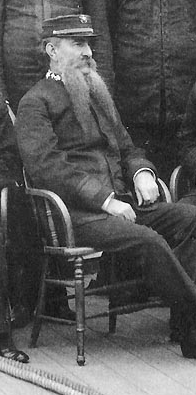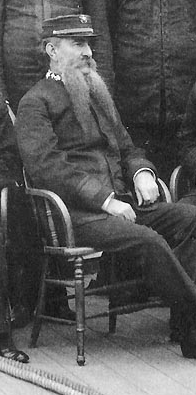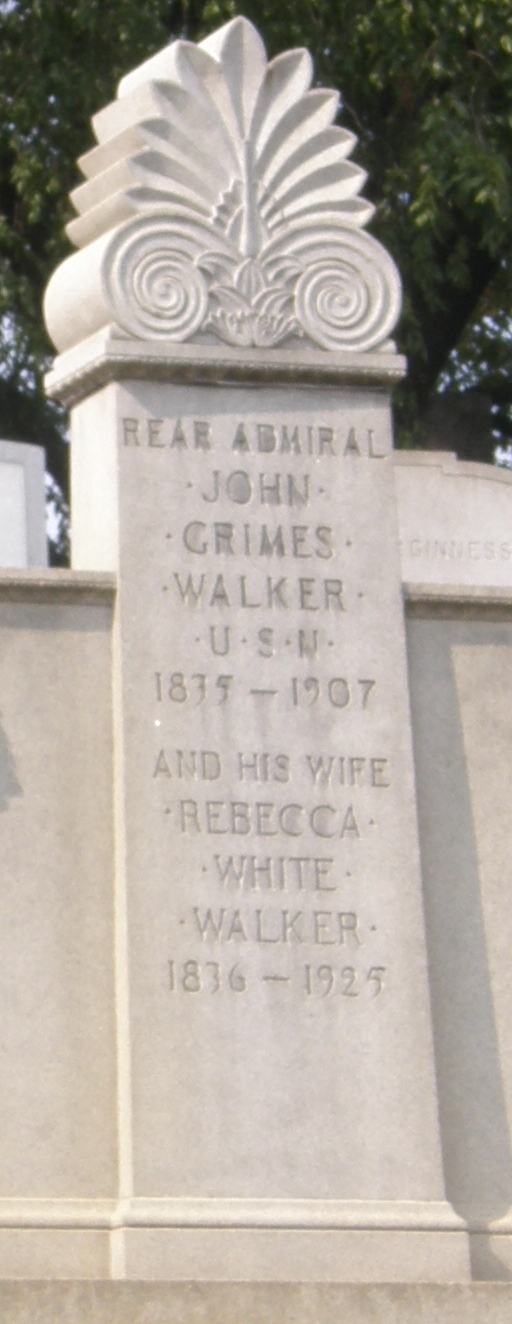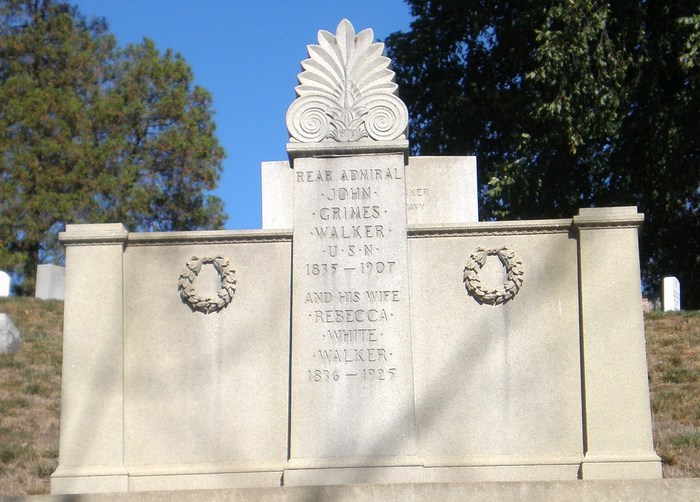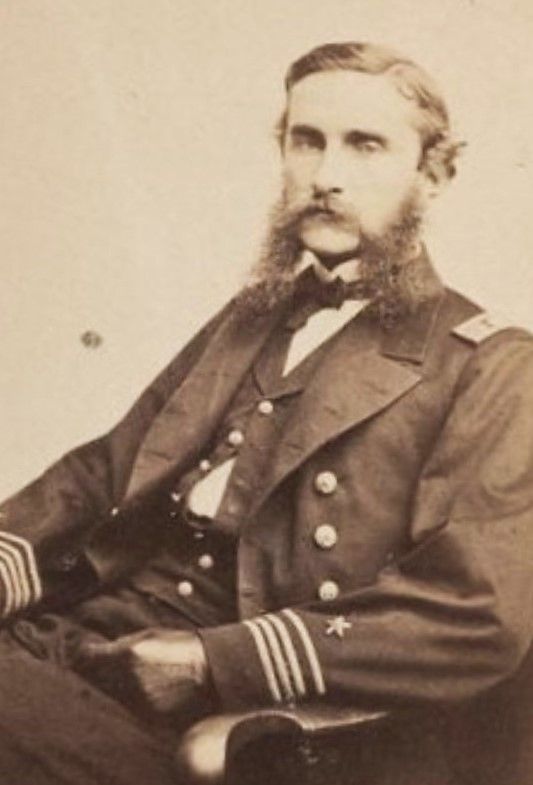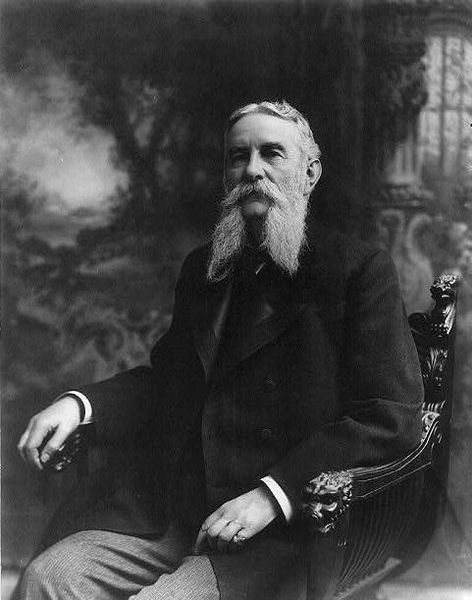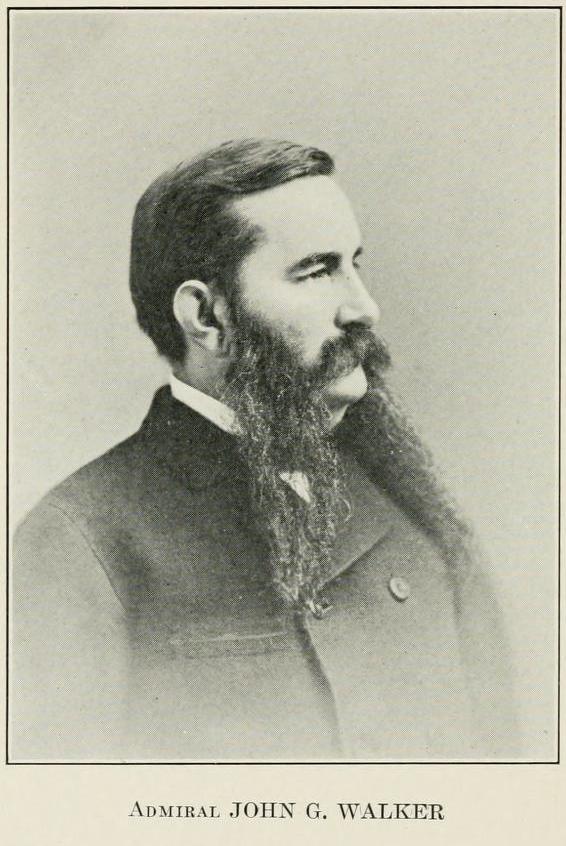Among the many men and women who have won distinction outside of the town few deserve higher mention than the subject of this sketch, John Grimes Walker. B. in Hillsborough, N.H., March 20, 1835, the son of Alden and Susan (Grimes) Walker, he was the grandson of Samuel and Anna (Carpenter) Walker and of John and Elizabeth (Wilson) Grimes. The Walkers were descendants of Widow Walker, of Rehoboth, Mass., whose name first appeared on the town records in 1643.
His parents removing to Iowa when he was young, his education was largely acquired there, and at the age of fifteen years, in 1850, he was appointed to the United States Naval Academy, to graduate at the head of his class in 1856. He was attached to the warship "Portsmouth," famous as having been the first ship to fly the stars and stripes in the harbor of San Francisco in 1846.
He was made Master in 1858. He served on the "Falmouth," and on the "St. Lawrence" in 1858-1859. He became instructor in mathematics. Was on the "Susquehanna" in 1860-1861 ; on the
"Connecticut" in 1861, and the gunboat "Winona" in 1861-2. Under Farragut, he participated in the engagements of Forts Jackson and Philip, in the capture of New Orleans, and for two years
was in every fight on the Mississippi. He commanded the "Baron de Kalb" in both engagements at Vicksburg (1862-3), in two attacks on Haines' Bluff at Arkansas Post, doing such gallant duty
he was reported by Commander-in-Chief Porter for his heroic conduct. In fact, he displayed such unusual qualifications he was brought to the attention of his leaders.
The "Baron de Kalb," under Commander Walker, in fact did herculean work at Fort Pemberton, capture of Yazoo City, clearing obstructions from the river and in the destruction of Confederate steamers carrying cotton and munitions of war. He was in command of gunboats "Saco" and "Shawmut" in 1864-5, and was present at the bombardment of Forts Anderson and Caswell on Cape Fear river, and at the capture of Wilmington, N. C, after the surrender of Fort Fisher.
In 1866 he was specially promoted to commander and was in the service of the Naval Academy as assistant superintendent in 1866-1869. Took the "Sabine" on a trip to Europe in 1869-1870, with a class of midshipmen ; was Secretary of the Lighthouse Board in 1873-1878.
He was appointed Chief of the Bureau of Navigation in 1831, holding the position for eight years,
being chief professional adviser to the Secretary of the Navy. Reached grade of commander in 1889, and was appointed Rear Admiral in command of the "White Squadron," visiting Europe
and South America. His flagship was the "Chicago." In 1894 he was placed in commander-in-chief of the Pacific squadron, and hurried to Honolulu to preserve peace at a critical time. His
conduct was highly approved by the United States.
On his return, he was appointed chairman of the Lighthouse Board, a position only a strong man could fill. In 1896, in addition to his other duties, he was chosen chairman of the Deep Water Harbor Board, to locate a deep water harbor in Southern California, by the United States.
Having reached the age limit, sixty-two years, in 1897, he was retired, his appointment as Admiral having been made three years before. But he was not allowed to remain idle, and in 1897 he was made President of the Nicaragua Canal Commission, and in 1899 he was appointed President of the Isthmian Canal Commission, to investigate and report on all practicable routes for a canal across the American isthmus, work then being considered. It is to his inestimable judgment and services that the government are indebted for much of the success of that gigantic undertaking — a service so little known it has never received the credit it deserves.
He was a member of the Metropolitan Club of Washington, and University Club of New York. The University of Pennsylvania in 1903 conferred on him the degree of LL. D. He died at York Beach, Me., Sept. 16, 1907, in his seventy-second year.
He m., Sept., 1866, Rebecca White, dau. of Henry White Pickering of Boston and Salem, Mass. Five children were born to this couple: Francis Pickering, James Wilson Grimes, Susan Grimes, Henry Pickering, and Sarah Cochran Walker. Two daughters, Alice and Bessie, died at early ages.
Source: History of Hillsborough, N.H.
Among the many men and women who have won distinction outside of the town few deserve higher mention than the subject of this sketch, John Grimes Walker. B. in Hillsborough, N.H., March 20, 1835, the son of Alden and Susan (Grimes) Walker, he was the grandson of Samuel and Anna (Carpenter) Walker and of John and Elizabeth (Wilson) Grimes. The Walkers were descendants of Widow Walker, of Rehoboth, Mass., whose name first appeared on the town records in 1643.
His parents removing to Iowa when he was young, his education was largely acquired there, and at the age of fifteen years, in 1850, he was appointed to the United States Naval Academy, to graduate at the head of his class in 1856. He was attached to the warship "Portsmouth," famous as having been the first ship to fly the stars and stripes in the harbor of San Francisco in 1846.
He was made Master in 1858. He served on the "Falmouth," and on the "St. Lawrence" in 1858-1859. He became instructor in mathematics. Was on the "Susquehanna" in 1860-1861 ; on the
"Connecticut" in 1861, and the gunboat "Winona" in 1861-2. Under Farragut, he participated in the engagements of Forts Jackson and Philip, in the capture of New Orleans, and for two years
was in every fight on the Mississippi. He commanded the "Baron de Kalb" in both engagements at Vicksburg (1862-3), in two attacks on Haines' Bluff at Arkansas Post, doing such gallant duty
he was reported by Commander-in-Chief Porter for his heroic conduct. In fact, he displayed such unusual qualifications he was brought to the attention of his leaders.
The "Baron de Kalb," under Commander Walker, in fact did herculean work at Fort Pemberton, capture of Yazoo City, clearing obstructions from the river and in the destruction of Confederate steamers carrying cotton and munitions of war. He was in command of gunboats "Saco" and "Shawmut" in 1864-5, and was present at the bombardment of Forts Anderson and Caswell on Cape Fear river, and at the capture of Wilmington, N. C, after the surrender of Fort Fisher.
In 1866 he was specially promoted to commander and was in the service of the Naval Academy as assistant superintendent in 1866-1869. Took the "Sabine" on a trip to Europe in 1869-1870, with a class of midshipmen ; was Secretary of the Lighthouse Board in 1873-1878.
He was appointed Chief of the Bureau of Navigation in 1831, holding the position for eight years,
being chief professional adviser to the Secretary of the Navy. Reached grade of commander in 1889, and was appointed Rear Admiral in command of the "White Squadron," visiting Europe
and South America. His flagship was the "Chicago." In 1894 he was placed in commander-in-chief of the Pacific squadron, and hurried to Honolulu to preserve peace at a critical time. His
conduct was highly approved by the United States.
On his return, he was appointed chairman of the Lighthouse Board, a position only a strong man could fill. In 1896, in addition to his other duties, he was chosen chairman of the Deep Water Harbor Board, to locate a deep water harbor in Southern California, by the United States.
Having reached the age limit, sixty-two years, in 1897, he was retired, his appointment as Admiral having been made three years before. But he was not allowed to remain idle, and in 1897 he was made President of the Nicaragua Canal Commission, and in 1899 he was appointed President of the Isthmian Canal Commission, to investigate and report on all practicable routes for a canal across the American isthmus, work then being considered. It is to his inestimable judgment and services that the government are indebted for much of the success of that gigantic undertaking — a service so little known it has never received the credit it deserves.
He was a member of the Metropolitan Club of Washington, and University Club of New York. The University of Pennsylvania in 1903 conferred on him the degree of LL. D. He died at York Beach, Me., Sept. 16, 1907, in his seventy-second year.
He m., Sept., 1866, Rebecca White, dau. of Henry White Pickering of Boston and Salem, Mass. Five children were born to this couple: Francis Pickering, James Wilson Grimes, Susan Grimes, Henry Pickering, and Sarah Cochran Walker. Two daughters, Alice and Bessie, died at early ages.
Source: History of Hillsborough, N.H.
Family Members
Sponsored by Ancestry
Advertisement
Explore more
Sponsored by Ancestry
Advertisement
